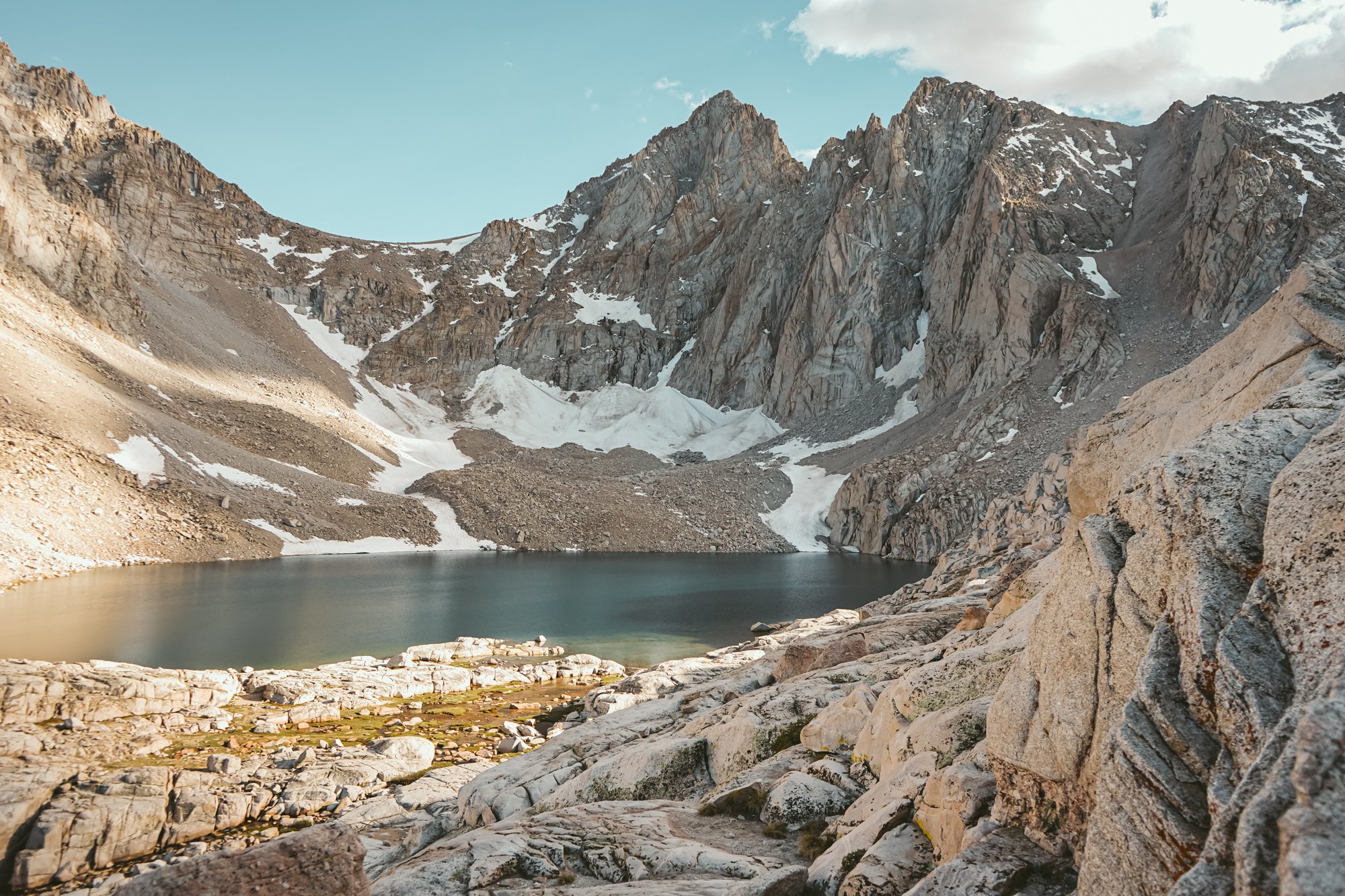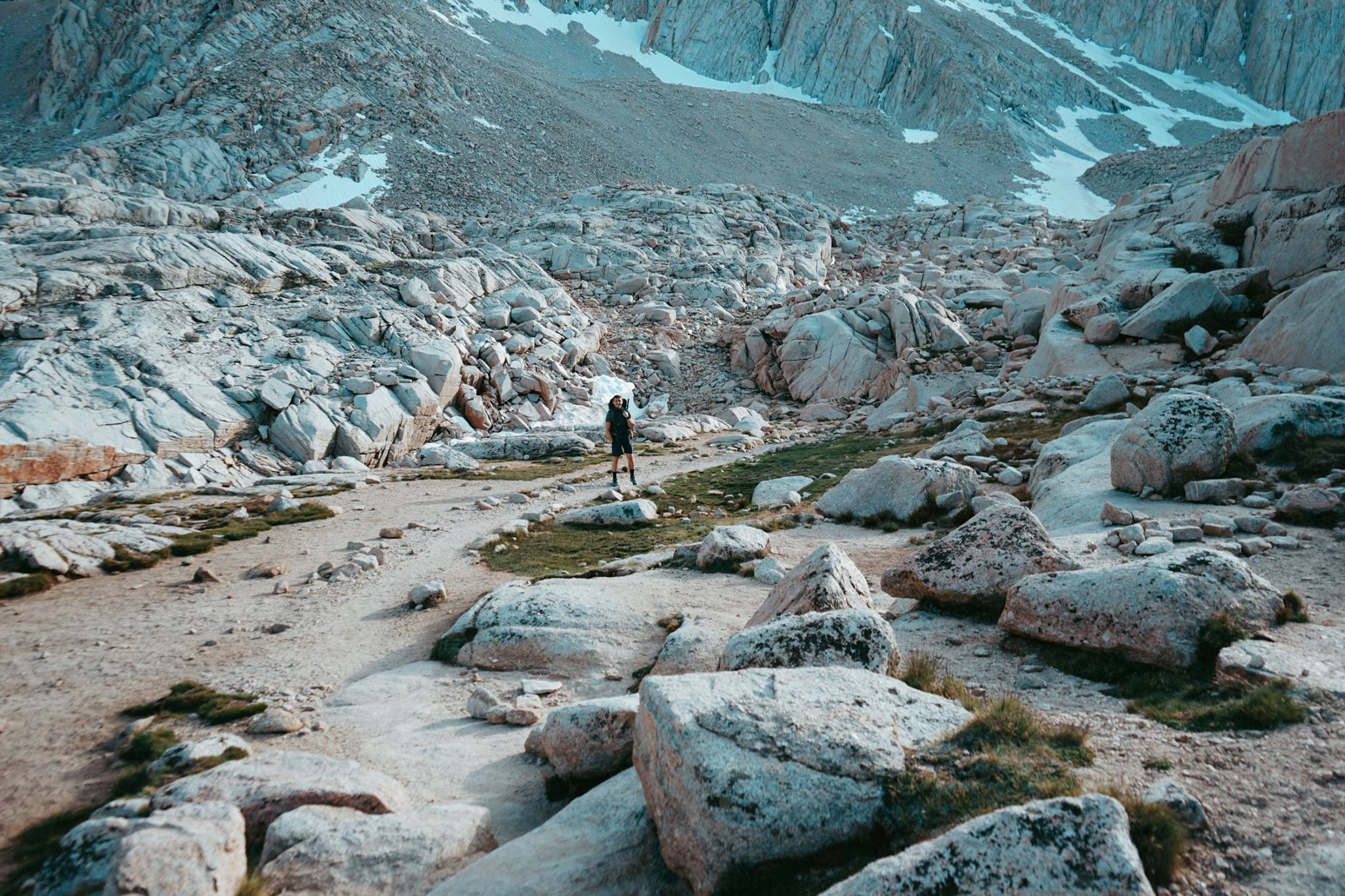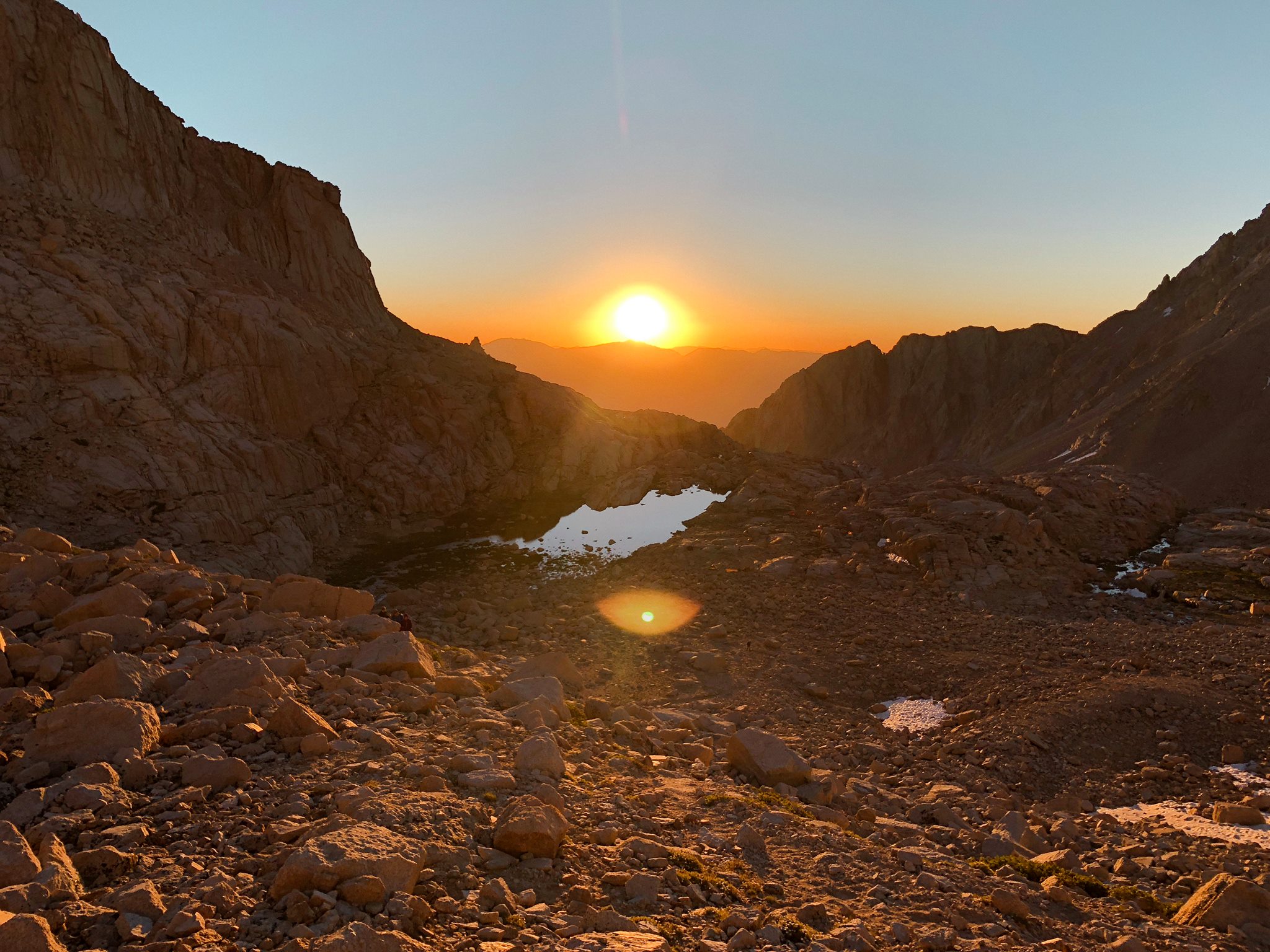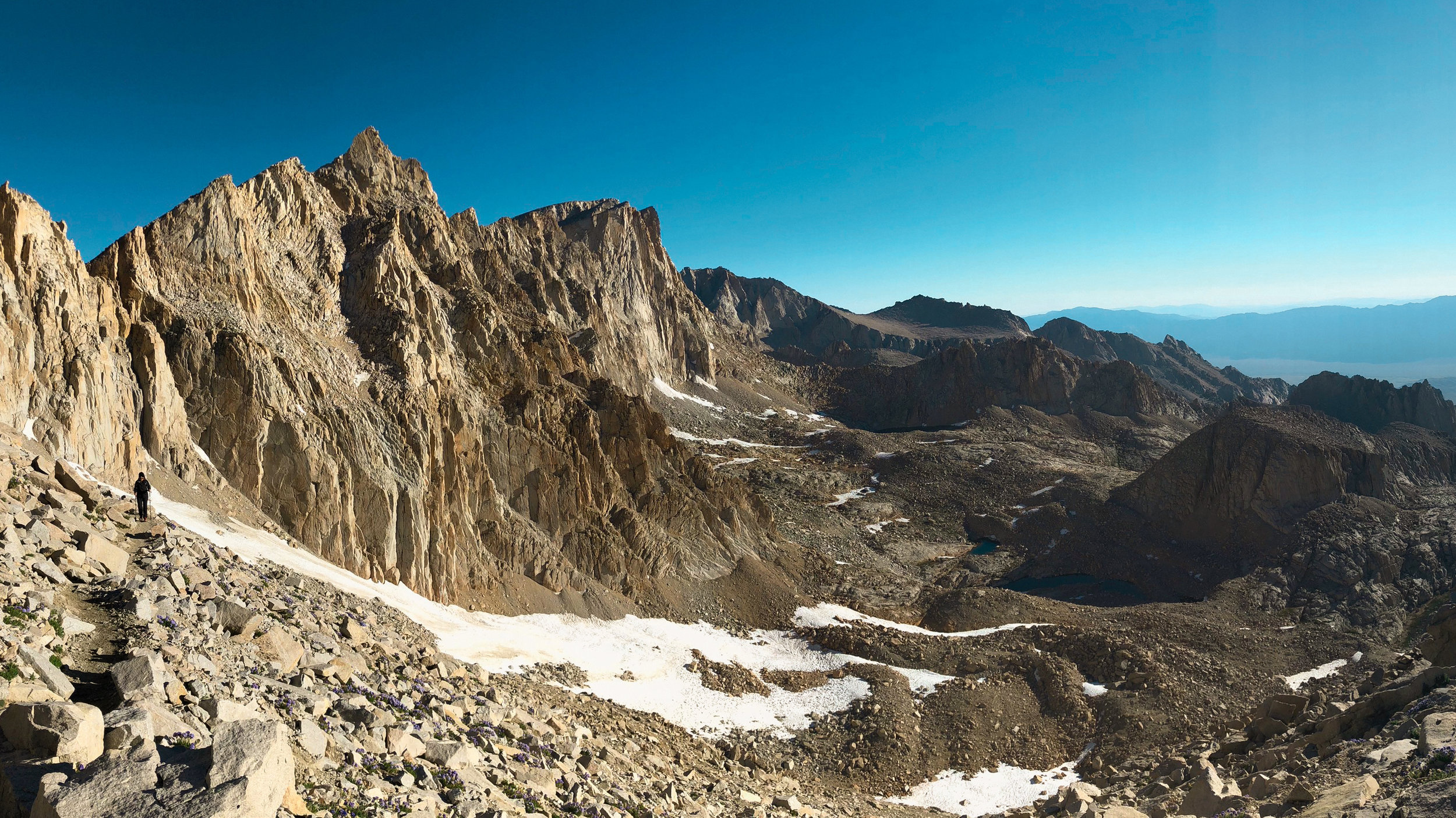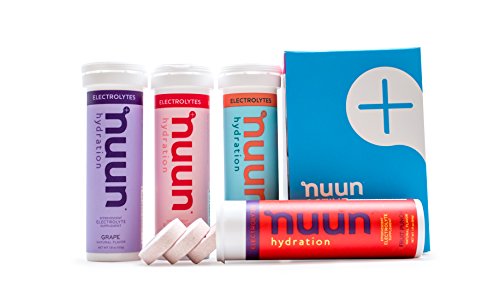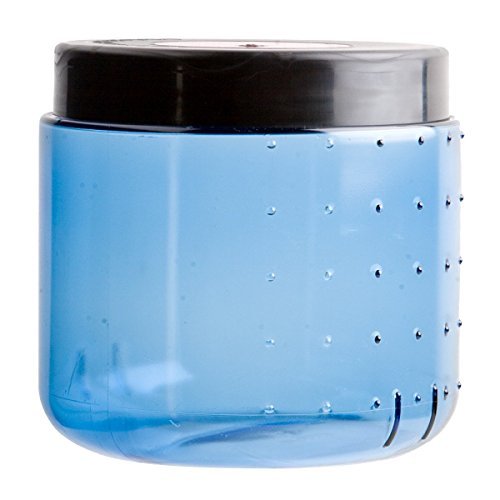Summiting Mt. Whitney via. Mt. Whitney Trail
I was home for the Holidays in the winter of 2017 when my brother and I solidified our deal to summit Mt. Whitney together in the summer of 2018. Even though we made a verbal agreement it still seemed a far off dream. Plus, the odds of getting a permit for the dates we wanted seemed slim to none.
That following April, while I was on my usual workday lunch-break-walk to Whole Foods, I got a text from my brother; we had miraculously secured overnight permits for the trail from June 30th - July 1st. Upon reading those words, I stopped dead in my tracks. This was really happening.
The Prep
Obtaining the opportunity to climb Mt. Whitney is in and of itself an uphill battle. This hike is extremely popular. In 2016, there was something like 65,000 people that wanted to hike or backpack to the summit from Whitney Portal during between June-September (prime hiking season). Because of that, a quota system has been enforced that allows only 100 day hikers and 60 backpackers at a time to hike from Whitney Portal between May 1st and November 1st. You can gain one of these quota-controlled spots by entering the lottery. Securing a spot is not an easy task, and you will have to attempt to get your permit a couple months in advance.
The lottery for the trail is open between February 1 and March 1 and permits can be reserved via recreation.gov. Once the lottery closes, you have until April 21 to pay for the permits and solidify your permits. If you do not pay by this point in time, your permits will be released and available to others starting April 22.
Initially, my brother forgot to enter us into the lottery (I only found this out after the fact) but when they reopened the lottery in on that April 22 date for cancellations, we miraculously locked down overnight permits for the last weekend of June, during a nearly full moon and our conditions were absolutely perfect.
Now let's talk about the nitty gritty. Mt. Whitney tops out at 14,505 feet, making it the tallest peak in California AND in the Contiguous United States. The Mt. Whitney Trail is a round trip total of about 22 miles with nearly 6,200+ ft. of elevation gain, and while in the summer-time it requires little to no mountaineering skills, it is still a long, grueling hike and the extreme altitude and sporadic weather is nothing to mess around with.
As soon as my brother gave me the news that we had secured spots for the end of June I realized, I only had 2.5 months to prepare. Now, let’s be real, I'm an Art Director at a branding agency. There are days I work till midnight, with my butt sat in a chair staring at a screen for hours on end. Not to mention, after my wedding in 2017, I had been giving myself a real hall pass when it came to working out. So physically, I was not in the right kind of shape to be climbing something of this magnitude.
Prioritizing my exercise was crucial. During the week, I would make sure to either find trails outside with considerable elevation gain, or utilize the treadmill and stairmaster at the gym when that wasn’t possible. I also began consistently working HIIT and yoga into my schedule. For me, when it comes to hiking, a lot of the struggle is mental stamina, and I knew there would be a lot of monotonous switchbacks on the Whitney Trail, so building some similar-style hikes into my routine was crucial as well.
At the time of obtaining our permits I had only ever hiked and camped at most around 8,000 feet in elevation. On top of that, living in Los Angeles means I spend all my time at sea level, so altitude sickness was a real concern of mine.
I read a lot about AMS in preparation for this hike. Probably too much for my own good. I discovered that a lot of people take Diamox (I did not) which is a prescription drug said to help with the side effects of altitude sickness. I also read that hydrating in advance, taking ibuprofen before and during your hike, and some elevation acclamation a day or two beforehand were essential. I wasn’t able to follow all of the tips by the book, but I did what I could. The week before our trip I made it a goal to drink a gallon of water every day, I also had Tylenol at the ready, which I took on the morning of both of our days on the mountain. While I had some moments of exhaustion up there, I never experienced any nausea, stomach issues, confusion or headache (I'm extremely prone to migraines so my head was a real concern), so it seems something was working in my favor.
Another great way to prep for this adventure is to get some high-elevation and longer distance hikes under your belt. Because of my schedule, I unfortunately didn't get to train much above 9k but I did make sure to solo-hike Mt. Baden Powell about 4 weeks out from our trip. This is one of those great mental training hikes I was talking about. MBP has a number of monotonous switchbacks, a decent amount of mileage for a day hike, and half the trail is above 8k.
Knowing that the first leg of our trek would be about 6 miles, I logged plenty of local lower elevation 6+ mile hikes in leading up to the trip. There are loads of those throughout Southern California - AllTrails is definitely your friend when planning your training hikes.
If you're in Southern California, here are some other great training hikes:
Mt Baden Powel (8.5 miles, 2600 ft. gain)
Mt Baldy via the Devil’s Backbone (11 miles, 3800 ft.gain)
Mt Wilson from Chantry Flat (14 miles, 4100 ft. gain)
San Bernardino Peak Hike (16 miles, 4600 ft. gain)
San Gorgonio Hike (18.5 miles, 5400 ft. gain)
San Jacinto from Idyllwild (19 miles, 5000 ft. gain)
You can also prep by joining Socal Hiker's 6 Pack of Peaks challenge (it has includes most of the above peaks). I haven't attempted it yet - but it's an awesome pursuit either way.
Aside from hiking and exercising I did a lot of armchair research. My husband can certainly vouch for that. I might have driven him a little nuts every night before bed, scrolling through the Whitney Forums, looking at the trail conditions or checking posts on the Mt. Whitney Facebook Group. I was obsessed, because I quickly realized, that while we had a fairly dry winter here, the weather just wasn't warming up enough on the mountain leading up to our trip. The snow and ice that had accumulated along the most dangerous portion of the 99 switchbacks (the chains) wasn't melting, which meant the usual trail from Trail Camp to Trail Crest could potentially be closed. If that trail didn't open, it meant the only way up was up the via the snow chute - a 1,200 vertical ft. snow field that requires crampons, an ice-axe and a bit more technical mountaineering skills. At the time, I was confident in my hiking abilities, but this kind of mountaineering was unknown territory for me. I had no prior glissading or self arrest training and I was very nervous it was going to bring our dream of summiting to a hault.
That said, if you are heading up there before July and after September and you don't have any kind of winter mountaineering experience you should definitely invest some time in learning. REI offers classes during specific times of the year and I also found some other outfitters in the Bishop and Mammoth areas that offer day-long classes. The conditions up there are always changing and weather is never consistent season to season so it's a great skill to have in your back pocket regardless.
The Climb
Before I knew it, my brother was landing at LAX and we were huddled in my living room shaking out our gear. That evening we made sure fill up on plenty of carbs and then came home early to get a proper night's sleep before heading to Lone Pine the following morning.
We got a later start than we intended, hitting the road around 8am, and arriving in Lone Pine to pick up our permits about 11am. After waiting about a half hour to get checked in and receive our passes, we were finally free to head up the windy road to Whitney Portal. When we arrived at the portal it reminded me, that while we're heading into the wilderness, we're still just a short distance from LA–the parking situation reflected that. It was no easy feat to find legitimate parking spot, and part of me began to panic that we'd be circling for hours losing precious day light. Luckily, the circling didn't last long and we managed to find a spot in the overflow parking area. We made sure to clear out any scented items from our car. Bears are a very real problem in the area, and if they sniff out anything in your car, you just might return from your adventure to find one behind the wheel. Trust me, that's the last thing you want to find after hiking 22 miles.
At the portal there is a general store with basic gear, snacks and a menu of what we heard were some super tasty burgers. We picked up a couple last minute essentials from the store and quickly headed for the trail. As you approach the trailhead there is a station to weigh your pack. Mine clocked in just under 30 lbs. and my brother's was around 35 lbs.
The first half mile of the trail feels like your average forest trail. To be honest, this was the hardest part for me. Don’t get me wrong, the views here were beautiful, but I just wanted to get to the "good stuff". You know, the cascading waterfalls, the lush meadows, the alpine lakes–my impatience seemed to make my pack feel a lot heavier.
Around that half mile marker we reached our first of many stream crossings and the views began to open up. 0.3 miles later we found ourselves at the crossing of the North Fork of the Lone Pine Creek. This section is made famous for the downed logs that act as a bridge.
Eventually you will reach a junction with the Lone Pine Lake Trail around 2.8 miles in. I had heard about how beautiful Lone Pine Lake was, and while we were a little behind on our timing, my brother and I agreed to take the 0.1 miles trip down to it's shores. I only wish we had ditched our packs at the junction, the hike back up from the lake was no walk in the park, and forced us to dip into some of our energy reserves. Otherwise, this quiet detour off the main trail was definitely worth it. I've never seen a lake so glossy and blue in my life.
When we finished soaking in the views at Lone Pine Lake we retraced our steps back to the Whitney trail and continued on our way. This next section of the trail contained a lot of switchbacks, and during this stretch we finally broke 10,000 feet and officially entered the Whitney Zone. I felt a pang of emotion as we crossed over 10k. I had never been that high in elevation and while my pack was starting to literally weigh on me, I otherwise felt great.
Suddenly we began to descend and were greeted by Bighorn Park, a super lush meadow nestled right between these humongous granite monolith formations. This part of the trail is awe inspiring. We took a moment here to just stare up at our surrounding. It’s a magical spot.
Throughout this portion of the trail, we found ourselves crossing more low streams and having to get our feet a bit wet. Eventually we came upon Outpost Camp which is around the 3.8 mile marker and 10,360 feet in elevation.
Outpost Camp is the first of the two main camps on the Mount Whitney Trail. It's a beautiful spot to camp, but we made the decision to continue on up to Trail Camp to make our morning ascent a bit easier. However, if you're breaking your overnight trip up into multiple nights, I would highly recommend posting up here too. The scenery is absolutely stunning.
As we passed through Outpost Camp the ground began to change from soft dirt to full on granite and your feet and knees really start to feel it. We continued to gain elevation along the hard granite trail and as we made our way upward we found ourselves looking down over beautiful Mirror Lake. At this point Trail Camp begins to feel so close, but still so far.
My brother and I are very different hikers. He is fast and athletic and wants to get to where he is going without pause. I, on the other hand, am what you call a slow hiker. I love to take frequent breaks to take pictures, and gawk at the grandness of it all. You'll see in most of our photos and video he's always about 100 feet ahead of me waiting. But somehow we made it work without too much bickering. My brother started a system that helped motivate me to keep climbing: every 500 ft. of elevation we gained I was allowed to take a break where I could take my back pack off, snap some photos, nosh a little and give my shoulders a rest.
During one of our breaks above Mirror Lake we decided to rest in the shade of a giant boulder and fuel up on snacks. Just as we were hoisting our packs back on to head back up the trail we heard what sounded like a gun shot. It was extremely unnerving and a little confusing. But then, as I turned the corner around the boulder, I saw it: a massive rock slide was barreling down the side of the mountain just in front of us across the canyon.
Scale in the mountains is really hard to judge. We stood watching these massive boulders come tumbling down the face, taking out everything in it's path and then suddenly we were panicked... How far away was it really? Could it reach us? It was hard to tell, so just to play it safe we jumped back behind our giant boulder and waited until the sound of tumbling rocks subsided. To be honest, we were ever in any kind of real danger, but it was certainly a humbling moment and a reminder that we were in fact at the mercy of this massive mountain.
After this little scare, we quickly got back on the trail. We knew there wasn't much farther to go, and we were anxious to set up camp.
Around the 5.3 mile marker the trail begins to rise up the the side of Lone Pine Creek at Trailside Meadow where you will find the tiniest most beautiful little alpine meadow. This section also marked our last big push up to Trail Camp and as we ascended over this last steep section we caught our first glimpse of Consultation Lake. The site of the lake fueled our anticipation and gave me a little extra pep in my step knowing Trail Camp was just hundreds of feet away.
Finally at 6.3 miles, we were entering into Trail Camp at 12,039 feet of elevation. It’s a fairly large backcountry camp and feels like you're basically on the Moon. There is little to no vegetation, so if you find yourself up there on a windy day, it's great to pick a spot behind a boulder to help shelter you from the cold and wind. It was around 6pm when we arrived. We still had plenty of light left in the day and there wasn't much wind, but we made sure to quickly find a vacant spot and set up camp. We were hungry, tired and as soon as the sun set behind the needles towering above us we could feel the temperature drop significantly.
After filtering water from the small camp-side lake that is so eloquently dubbed "Pooh Lake" (thanks to all the WAG bags left behind at Trail Camp - don’t be like that PACK OUT YOUR POOH) we put on some extra layers and waited for the stars to come out. As the sky turned a deep, dark blue color we could start to make out little headlamps winding their way down the 99 switchbacks. After such a tiring afternoon, it was tough to keep our eyes open, but let me tell you, when the stars come out up there, they shine extra bright.
I tossed and turned for most of the night. The mixture of excitement and elevation was overwhelming, but by some miracle, when my alarm rang out at 5:00 am I was up and ready to get back on the trail.
We began ascending the infamous 99 switchbacks around 5:30am. Why are they infamous? Well, for one thing there are 99 of them (or 97 - it's a heated debate. We tried to count but lost it by the time we reached 40-something) and they stretch on for 2.2 miles rising just over 1,700 feet before hitting Trail Crest. Most people find them excruciatingly monotonous, but looking back, this actually felt like one of the most enjoyable parts of the trail. It may have just been the luck of our timing, but every turn I found more exciting than the next. In some areas you could hear the rush of the spring beneath the rock, there were beautiful little purple wild flowers sprouting seemingly out of no where and watching the sun rising was simply incredible. It also might have been my lack of sleep causing some delusion - if I recall correctly, this is also where I did A LOT of singing and talking to myself as my brother powered on ahead of me.
About 1.4 miles of the way up the switchbacks you'll find "the cables", a short section of the trail that has a cable like railing along the side. Before our trip, this had been a point of serious anxiety for me. We had heard stories just days before about someone trying to climb over the mass of snow still covering the trail, nearly slipping and falling to his death. So, yeah, that was cool.
However, when we arrived at the cables we were pleasantly surprised to see that nearly all of the snow and ice that had been obstructing the trail had melted! Still, the section is a bit nerve wracking - there is a reason they have installed a "railing" system here after all. Just be mindful of your footing here and you'll be fine.
As we trudged along we eventually ran into a group coming down from the summit who excitedly exclaimed "This is your last switchback!" We were so excited, until we quickly realized, it's also the longest, steepest switchback of them all, but it makes your arrival to Trail Crest that much more rewarding.
We made it to Trail Crest around 8am and I suddenly found myself getting a little emotional. At that moment, I just knew we were going to succeed. Everything before that seemed uncertain, but at Trail Crest, I could feel it.
At this point we only had 2.5 miles and about 845 feet of elevation gain to reach the summit. This was by far the longest 2.5 miles of my life. Knowing how close you are is somehow both invigorating and demoralizing at the same time. But you can't beat the views throughout this part of the trail.
After crossing through Trail Crest we found the trail began to descend. At first this is an exciting break for your legs, but then you remember the summit is still 1,500 ft. above you which can be a bit defeating. About half a mile after Trail Crest the trail intersects with the John Muir Trail. Here we ran into a lot of fellow hikers taking a break, or making their way up to Whitney from the JMT. This is a spot a lot of the JMT hikers leave their big packs and continue on with their day packs (we left our big packs back at our campsite). Because so many packs get left behind here, you'll also find this is a popular spot for Marmots. Keep your eyes peeled for these little buggers snooping around looking for any kind of treats they can get their paws on, and if you leave your bag here, make sure you food is securely hidden away.
As we made our way past the JMT junction the trail becomes primarily just slabs of super hard, knee-busting, granite. My feet and knees were not happy along the last stretch of trail, but as always, the views are a great way to find some relief.
Eventually we found ourselves coming upon a part of the trail I had was highly anticipating: The Windows. The Windows are a section of trail that passes behind the space between the thin needle-like peaks. The windows offer extremely steep, little peeks down to the other side where Trail Camp lies. Pictures do not do the vertical drop here any kind of justice. It is steep. And if you have any kind of vertigo or fear of heights, it's probably best to just keep walking.
From the windows it's about another 1.5 miles to the summit! Unfortunately, this part of the trail was pretty daunting. After a slight descent for a good 1 mile, you'll find yourself making up for that loss of elevation and it is no fun. Luckily, from there on out we could see the Smithsonian Hut perched upon the peak and somehow knowing it was just ahead in the distance kept us going strong.
Just before our last 500 ft. of elevation we took a short break. Words can't describe the feelings I had staring up at that last push before the summit. You know what, that's a lie, I did have some words, however most of them were expletives.
After cursing those last 500 ft. around 10am on July 1st, 2018 we were there. My brother let me walk those last 100 feet to the top in front of him and when we reached the hut he called out to me "How do you feel?" and my response was a very out-of-breath whisper, "We f*cking did it."
We allowed a good 45 minutes to rest at the top. We captured our happy summit photos, high-fived some fellow hikers we had been leap-frogging with, quietly face-timed our parents (yes, there is excellent cell service on the peak - but be mindful of your volume if you phone a friend - most people are trying to enjoy the serenity of it all) and then took a moment to ourselves to simply lie under the sun and soak it all in.
Around 10:45 am we started to notice some clouds building in the distance which was our cue to begin our descent. It was really hard to tear ourselves away from the summit, but the last thing I wanted was to ruin a perfect hike by getting stuck in a lightning storm on top of Mt. Whitney.
As we headed back down the trail I remember feeling as though the switchbacks took much longer to descend than to climb. The lingering thought of having to pack up our campsite and don those heavy packs again was putting a damper on my thus-far pleasant mood.
We arrived back at Trail Camp around 1pm and just as we packed up the last of our belongings we began to feel rain drops. This put a little extra pep in our step as we said goodbye to our campsite around 2pm and took off down the trail. I don't usually agree with the sentiment, but this time it felt very true: the way down is the harder than way up.
Around 6pm, after a single day of 16 miles, 22 miles total, 6,130 feet of elevation gain, 2 marmot sightings, 1 deer sighting and a miraculous 0 blisters, we threw our packs in the hatchback, collapsed into my car, and with our last tiny bit of energy left, headed back to LA.
Any Regrets?
There are only a few things I would change about this hike…
1. Pack lighter
This was my first time backpacking in California, and my first time with a bear canister as well. All things considered, I felt pretty good about my pack capping out around 25-30lbs. However, my next overnight backpacking trip I'll be sure to invest in a lighter sleeping bag. I currently have the REI Trail Pod 30º bag. It's a fairly light bag at the end of the day, and before this trip I just wasn't ready to invest in a lighter bag. Now, after the fact, I'd be more than happy to shell out some cash to shave off a pound or two. The Trail Pod also has a pretty big footprint - it takes up a lot of space in the pack. If any of you have a favorite ultra-light sleeping bags, let me know!
2. Enjoy the scenery
I wish I had "taken it in" more and brought my camera and GoPro to the summit on our second day. The morning of our summit bid, as we were preparing our day packs, I wanted to carry as little as possible - just some snacks, 3L of water, rain gear, first aid kit, a head lamp and my poles . The thought of the extra weight of my camera around my neck was exhausting. But in hindsight, after watching and re-watching my go-pro videos and photos from our first day, I wish I had that kind of footage of our triumphant summit. When you are really "in it" it's hard to allow yourself to take in the view. I mostly had my head down, calculating my every step and focusing more on keeping the pace than really soaking in the awe-inspiring scenery that surrounded me.
3. Train More Strategically
I mentioned I did some training leading up to this trip, but in all honestly, it was pretty haphazard. In the future, I would definitely invest more time in consistent strength training and do a few more high elevation 6-7 mile hikes leading up to something of this scale.
Have you summited the lower 48’s highest peak? Tell me about your experience in the comments…

